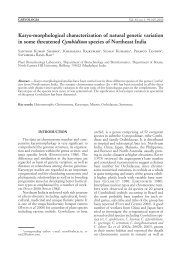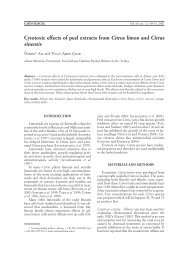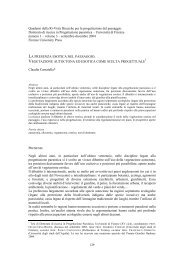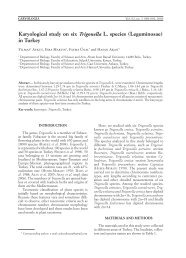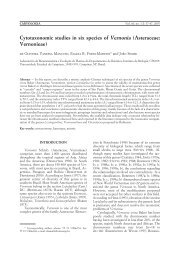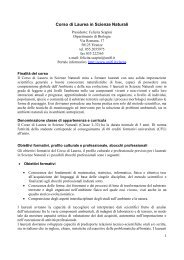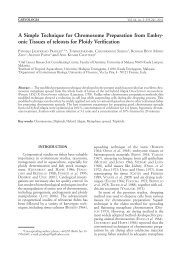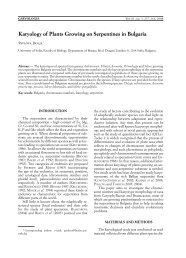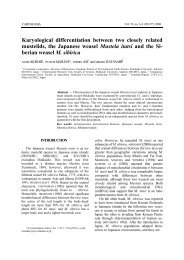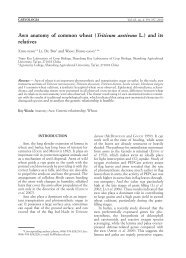A revised cytotaxonomy of the genus Tulbaghia (Alliaceae)
A revised cytotaxonomy of the genus Tulbaghia (Alliaceae)
A revised cytotaxonomy of the genus Tulbaghia (Alliaceae)
You also want an ePaper? Increase the reach of your titles
YUMPU automatically turns print PDFs into web optimized ePapers that Google loves.
98 VOSA<br />
its flowers it resembles T. violacea but cytologically it<br />
belongs to <strong>the</strong> T. cameroni group. It is a very desirable<br />
species from <strong>the</strong> horticultural point <strong>of</strong> view but it<br />
is deciduous and has proved to be somewhat difficult<br />
to cultivate, growing very slowly and flowering<br />
erratically.<br />
20. <strong>Tulbaghia</strong> violacea Harvey in Bot. Mag., 64: t.<br />
3555 (1837); Vosa, Ann. Bot. (Rome), 34: 113-117<br />
(1975) as <strong>Tulbaghia</strong> cepacea L.f.; Vosa, Jl. S. Afr.<br />
Bot., 46: 109-114(1980).<br />
TYPE — Described and illustrated from cultivated<br />
material in <strong>the</strong> Ludwigsburg Garden, Cape<br />
Town, by Harvey in Bot. Mag. 64, t. 3555, 1837<br />
(iconotype!).<br />
SYNONYMS — T. cepacea L.f. in Suppl. PL 194<br />
(1781) quoad descr. excl. syn., nom. illeg. type: 411/4<br />
(LINN); Omentaria cepacea Salisb. Gen. PL Fragm.<br />
87 (1866).<br />
ICONOGRAPHY — (Harvey I.e., Batten & Bokel-mann<br />
in "Wild Flowers <strong>of</strong> <strong>the</strong> Eastern Cape", p. 10, pi. 6,<br />
fig. 6,1966; Vosa, 1975, fig. 22, Plate XX: figs. 3, 4,5,22<br />
and 23, incl. var. as T. cepacea L.f.); Plate IVB.<br />
For <strong>the</strong> legitimacy <strong>of</strong> <strong>the</strong> name <strong>Tulbaghia</strong> violacea<br />
Harvey, see VOSA (1980).<br />
CHROMOSOME NUMBERS — 2n=2x=12 (karyo-type A,<br />
fig. 20).<br />
DISTRIBUTION — From <strong>the</strong> Transkei to <strong>the</strong> SW Cape<br />
near Port Elizabeth.<br />
EXSICCATA — CAPE. - 3227 (Stutterheim): Mt.<br />
Coke, near King William's Town, Compton 144/45<br />
(NBG); - 3228 (Butterworth): at <strong>the</strong> mouth <strong>of</strong> <strong>the</strong><br />
river Kei, Compton 17674 (NBG); - 3224 (Steytlerville):<br />
in rocky scrubland by <strong>the</strong> river Gantoos at<br />
Hankey, Vosa 371/23; 3323 (Willowmore): Zuurberge<br />
Poort, Barker 7132 (NBG); - 3326 (Grahamstown):<br />
in bed <strong>of</strong> dry stream among rocks in <strong>the</strong><br />
Bloukrans, Vosa 354/22,376/26 (OXF); - 3327 (Peddie):<br />
amongst stones in <strong>the</strong> bed <strong>of</strong> <strong>the</strong> river Buffalo,<br />
near East London, Vosa 308/17 (OXF); - 3424 (Humansdorp):<br />
Babeljouw River, Compton 24041 (NBG);<br />
near Humansdorp, Britten 6513 (GRA).<br />
VERNACULAR NAMES — KwaZulu: Icinzini.<br />
All <strong>the</strong> populations <strong>of</strong> <strong>Tulbaghia</strong> violacea, object<br />
<strong>of</strong> <strong>the</strong> present study, show a kind <strong>of</strong> uninterrupted<br />
variability and include a number <strong>of</strong> forms which reasonably<br />
might be given <strong>the</strong> rank <strong>of</strong> varieties. However,<br />
field experience and careful observations during<br />
a number <strong>of</strong> flowering seasons, all over <strong>the</strong> range <strong>of</strong><br />
<strong>the</strong> species and also on cultivated plants, have shown<br />
that considerable differences exist even between<br />
plants <strong>of</strong> <strong>the</strong> same population. Such differences<br />
include, besides <strong>the</strong> dimension <strong>of</strong> <strong>the</strong> plants,<br />
Fig. 20 — <strong>Tulbaghia</strong> violacea (2x), karyotype A.<br />
also <strong>the</strong> size <strong>of</strong> <strong>the</strong> flowers and <strong>the</strong> length and shape<br />
<strong>of</strong> <strong>the</strong> lobes <strong>of</strong> <strong>the</strong> corona. In a previous account by<br />
VOSA (1975), one each <strong>of</strong> <strong>the</strong> most common forms<br />
from two fairly large populations, located 200 km<br />
apart, have been described. A perusal <strong>of</strong> <strong>the</strong> descriptions<br />
shows indeed that <strong>the</strong> two forms differ, but only<br />
in some small details. Herbarium specimens, perforce<br />
limited in number, do not represent <strong>the</strong> intrinsic<br />
variability <strong>of</strong> <strong>Tulbaghia</strong> violacea populations and<br />
cannot be taken as <strong>the</strong> basis for <strong>the</strong> creation <strong>of</strong> <strong>the</strong><br />
taxonomic rank <strong>of</strong> varieties. The exception is <strong>the</strong><br />
establishment <strong>of</strong> <strong>the</strong> var. maritima by VOSA (1975).<br />
This variety is quite distinct morphologically from <strong>the</strong><br />
typical species and exists in fairly small but very<br />
homogeneous populations with a ra<strong>the</strong>r restricted<br />
habitat near <strong>the</strong> sea.<br />
20a. <strong>Tulbaghia</strong> violacea Harvey var. maritima<br />
Vosa, Ann. Bot. (Rome) 34: 113-117 (1975).<br />
TYPE — CAPE. - 3325 (Port Elizabeth): Gantoos<br />
River Mouth, Vosa, 290/12 (OXF) isotype G.<br />
ICONOGRAPHY — (Vosa 1975, fig. 23, Plate XX, fig.<br />
5, Plate IV, fig. 20a, as T. cepacea var. maritima); Plate<br />
IVC.<br />
CHROMOSOME NUMBERS — 2n=2x-12 (karyotype A).<br />
EXSICCATA — CAPE. - 3224 (Humansdorp): near<br />
<strong>the</strong> Krom River mouth, Vosa 63 (OXF); - 3323




